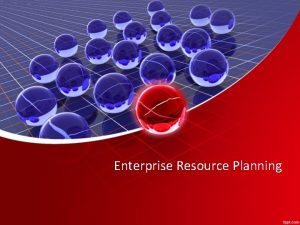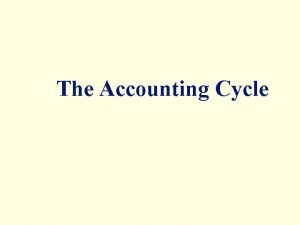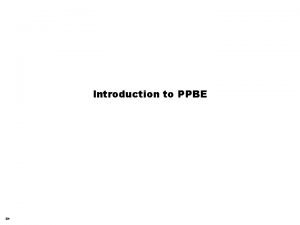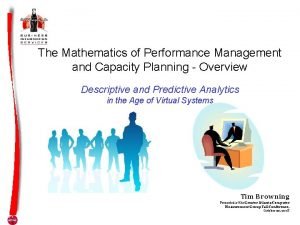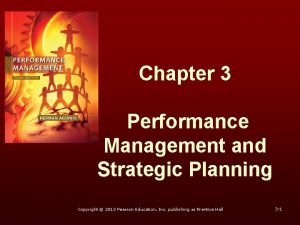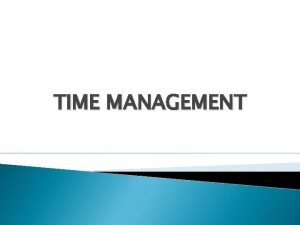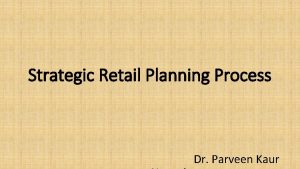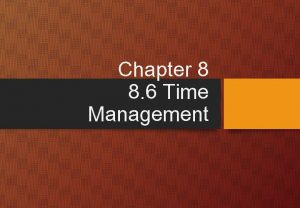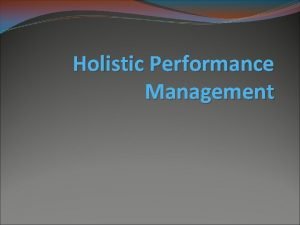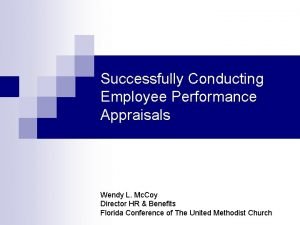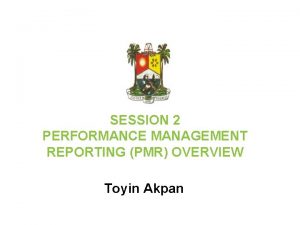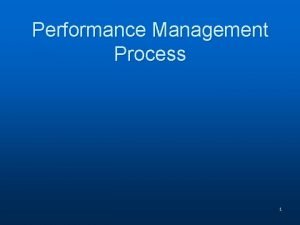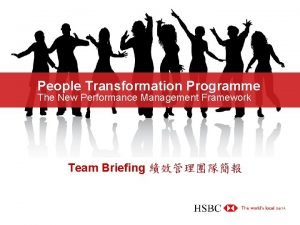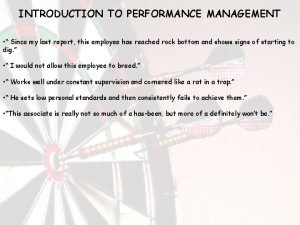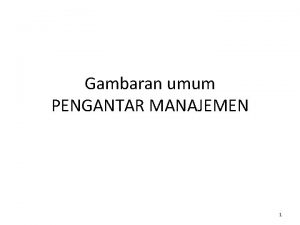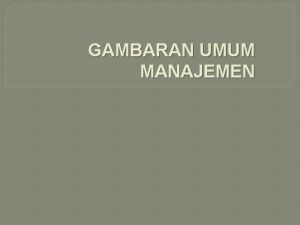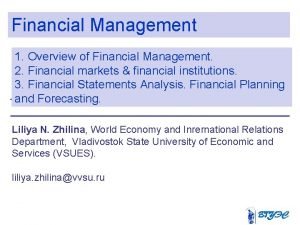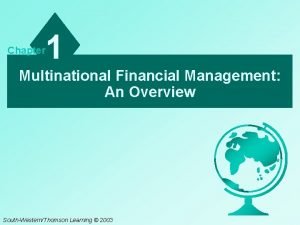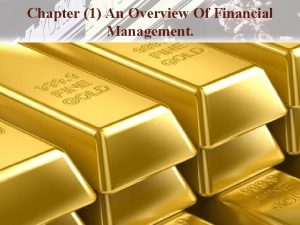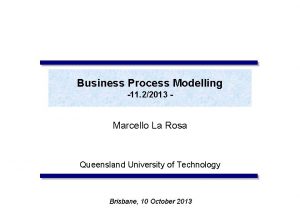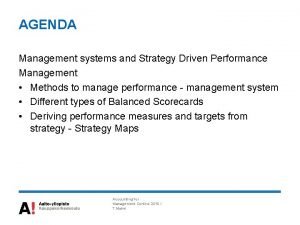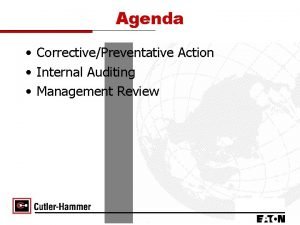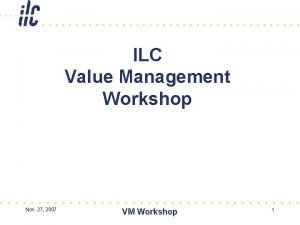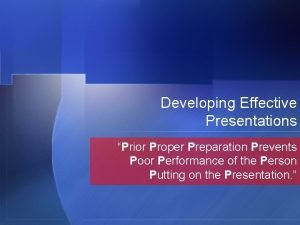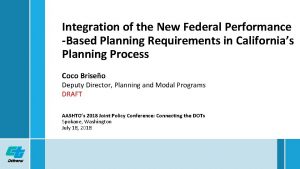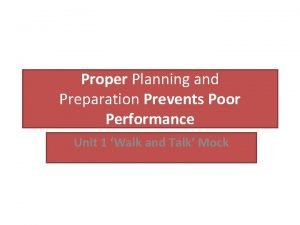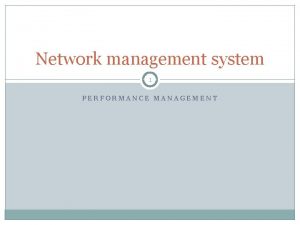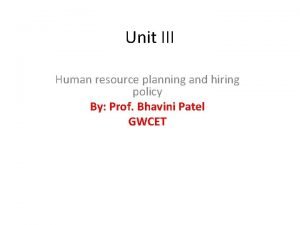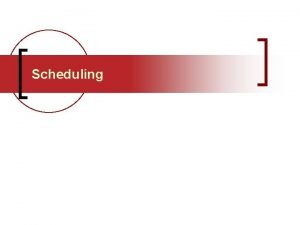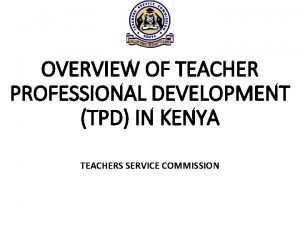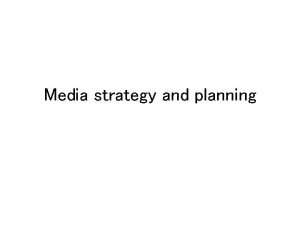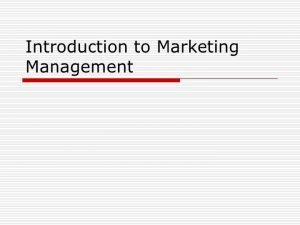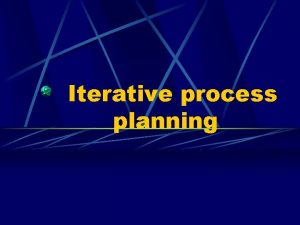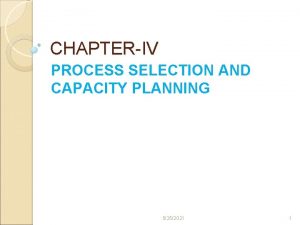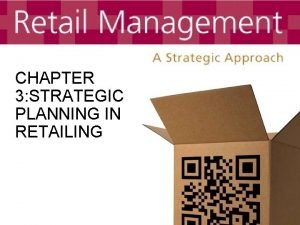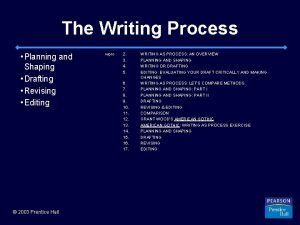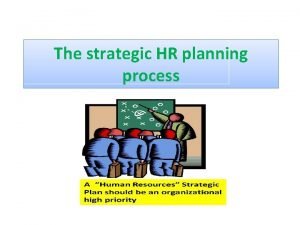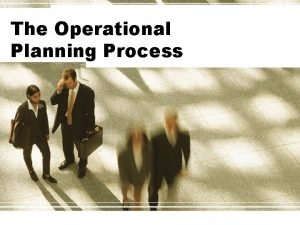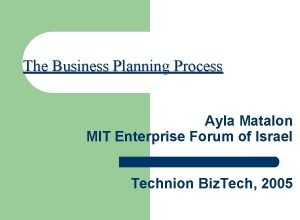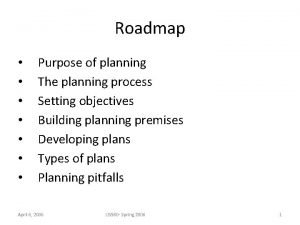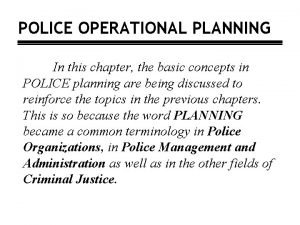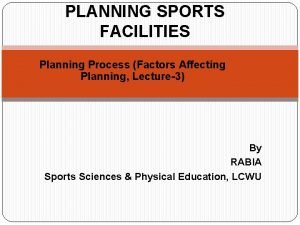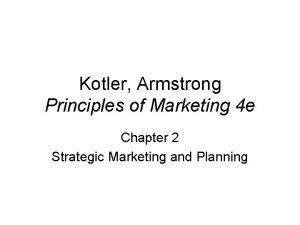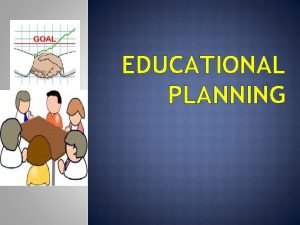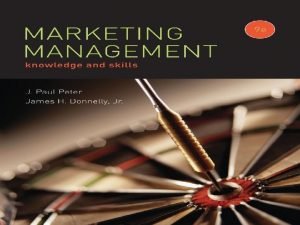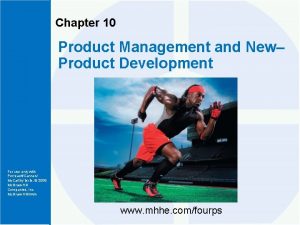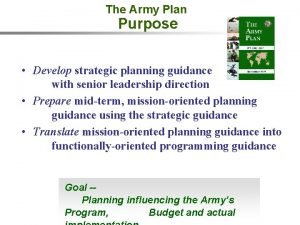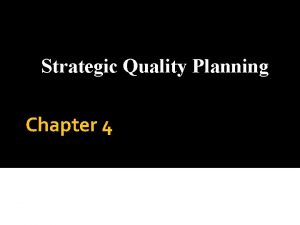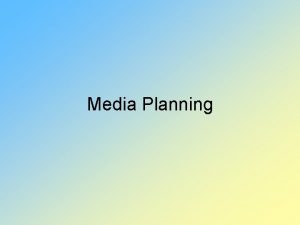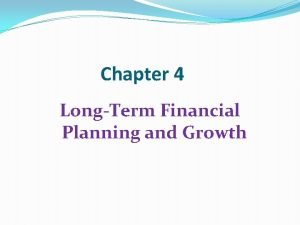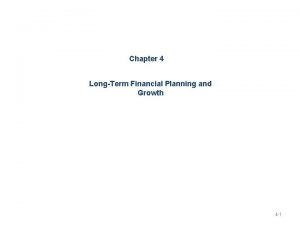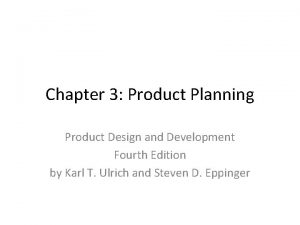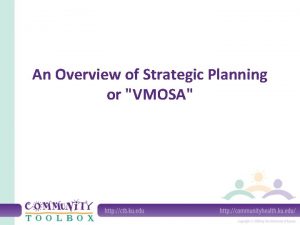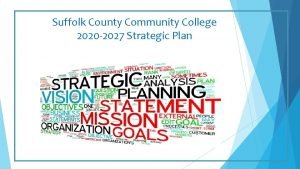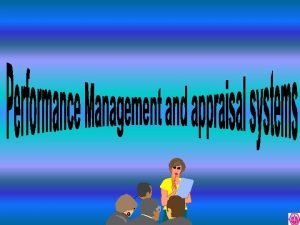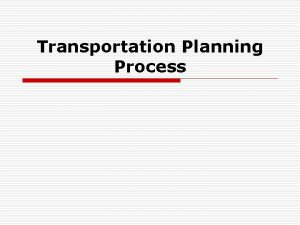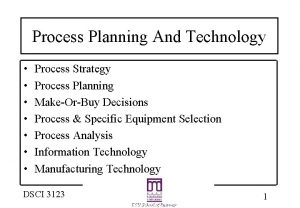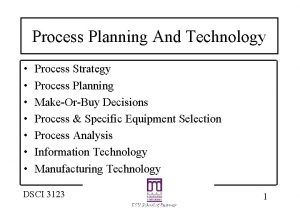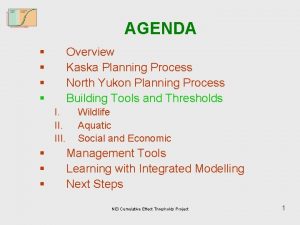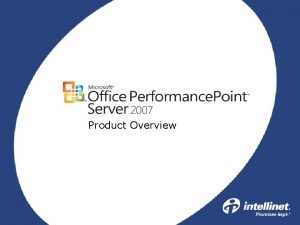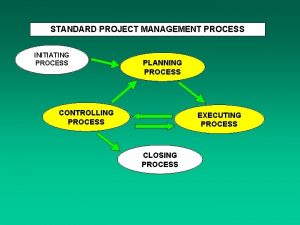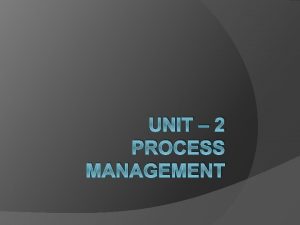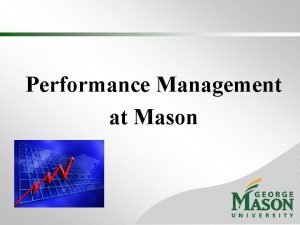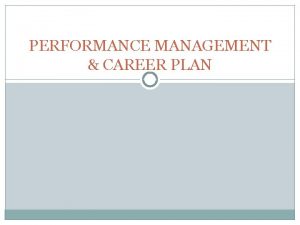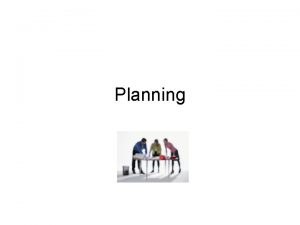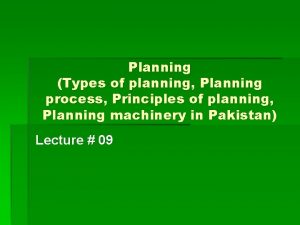Performance Management Process Agenda Performance Management Overview Planning






















































































- Slides: 86

Performance Management Process

Agenda • • • Performance Management Overview Planning, goal and expectation setting Performance Execution Writing a Performance Evaluation Conducting a Performance Discussion 2

PERFORMANCE MANAGEMENT OVERVIEW 3

What is Performance Management? Performance Management = a process for establishing a shared understanding about what is to be achieved, how it is to be achieved, and an approach to managing people that increases the probability of success. Weiss and Hartle, Reengineering Performance Management. St. Lucie Press (1997). 4

Question? Why focus on Performance Management? 1. Good performance management fosters good performance Top 1% of performers are 12 times more productive than the average performer 2. Good performance reduces turnover The #1 reason people quit their jobs is their immediate supervisor 5

Why Have Performance Management? Performance Management offers several advantages at the level of the: – Individual Recognition of past effort Developmental requirements can be uncovered – Team Alignment of effort with goals Motivation for team members – Organization Development of staff Achievement of key goals Best and focused utilization of human capital 6

Overall Benefits of Performance Management • • • Increased employee performance Clearer communication of expectations Improved motivation and commitment Increased communication and information Better relationships within & across the organization 7

Question? What is the role of the manager and the employee in effective performance management? What are the advantages to the manager and the employee? 8

Manager’s Role in Performance Management • Set goals with employees • Define the standards of performance • Engage employees in two way conversation to establish buyin • Offer accurate, timely, regular & specific feedback 9

Advantages to Managers • • • Translate goals into individual job performance and standards Monitor performance and offer feedback Communicate and seek agreement on goals Coach employees on how to achieve their goals Identify employees strengths and growth areas Generate and agree on growth plans to best serve the organization and individual needs 10

Employee’s Role in Performance Management • Discuss and commit to goals and performance objectives with manager • Improve performance • Discuss development, tools and resources necessary to achieve goals • Be actively involved in their development • Communicate accomplishments and potential barriers for meeting the goals 11

Advantages to Employees • • Openly discuss performance with managers Be provided with a development tool Reinforce and sustain performance Improve existing performance Determine career progression goals Identify development needs Link rewards to performance 12

Goal of Performance Management The overall goal of performance management is to ensure that the organization and all of its subsystems (processes, departments, teams, employees, etc. ) are working together in an optimum fashion to achieve the results desired by the organization. 13

“If you don’t know where you are going any road will take you there. ” -Yiddish Proverb S. M. A. R. T GOALS & PERFORMANCE OBJECTIVES 14

Planning: topics to cover • • SMART Goals Performance Objectives Expectations Growth Plans Phase 1 Planning 15

Activity Why don’t employees do what they are supposed to do? List 1 -5 and provide reasons # 1 reason: don’t know what to do # 2 reason: don’t know how to do it # 3 reason: don’t know why they should # 4 reason: they think they are doing it # 5 reason: there are obstacles beyond their control Ferdinand F. Fournies survey 2000 16

Question? What do these reasons have in common? They are all partially beyond the control of the employee. They are all, in part, problems to be remedied by the manager. 17

What is a S. M. A. R. T Goal § S = SPECIFIC § M = MEASURABLE § A = ACHIEVABLE § R = RELEVANT § T = TIME-BOUND Phase 1 Planning 18

What are Performance objectives? • Depending on your position you may create performance objectives which are actions that need to take place, milestones or data that will keep you on track to reach your goal. Phase 1 Planning 19

Share your SMART Goals • In pairs share your SMART goals and give feedback Phase 1 Planning 20

Managing and Discussing Expectations • Overview of role • Outline your expectations based on the goals and Leadership Essentials • Be prepared to give examples of exemplary and proficient behaviors Phase 1 Planning 21

Focus on Employee Growth • Facilitate dialog with the employee which focuses on their future development • Communicate suggestions that will enable the employee to be successful in their role Phase 1 Planning 22

PERFORMANCE EXECUTION “Employees work on two things, what they like to do and what you measure. ” - Anonymous 23

Performance Execution Topics to Cover • • Monitoring Feedback Coaching Progressive Discipline * *Progressive discipline process – do not combine with Performance Review Phase 2 Performance Execution 24

Monitoring What tools and processes do you use to monitor employee performance? Phase 2 Performance Execution 25

Maintaining Employee Data • Objective data • Significant/critical incidents • Observations • Performance records • Discussion records are an extension of the employee’s personnel file • You are responsible to keep the files in a secure area • Responsible for content and needs to be factual (behavioral type language) Phase 2 Performance Execution 26

Feedback sessions = reviewing a body of work or overall performance. Not an everyday occurrence – Sometimes planned in advance – Usually a “sit down” session – Typically more time intensive • Typically will be numerous “pieces” of feedback within the session Incidental feedback = delivering a message regarding a specific behavior/issue. Should occur frequently – Tends to be brief – Typically informal – Positive or developmental Phase 2 Performance Execution

Feedback: Why and When? Why? – Raise awareness – Create accountability – Help develop the employee When? – When an occurrence has happened – One-on-one meeting – Team meetings Phase 2 Performance Execution 28

Feedback Model for Performance Development Ask three simple questions before you give your feedback (and remember to listen) » What went well? » Where did you get stuck? » What would you do differently? Phase 2 Performance Execution 29

STAR Feedback Model STAR Feedback to reinforce behaviors that lead to positive results S/T Situation = Identify the situation or task the person was doing STAR/AR Feedback to redirect behaviors that lead to better results S/T Situation = Identify the situation or task the person was doing A A Action = Describe the actions- what he/she said or did R Result = Describe the results of his/her actions on you, others, the organization, etc. R Action = Describe the actions- what he/she said or did Result = Describe the results of his/her actions on you, others, the organization, etc. AR Alternative actions & results = Suggest alternative actions that would lead to the desired results. You can “ask” for alternatives or “tell” what you want to see

RECEIVING FEEDBACK CHALLENGES Phase 2 Performance Execution 31

The Arguer • Avoid getting dragged into argument regarding the past ▪ “…You are wrong!” ▪ Denies the problem ▪ Argues over the evidence • Start with the facts and try to establish agreement on the facts • If you cannot establish the issue as a problem due to different interpretations of the facts, at least agree to expectations going forward 32

The Defender ▪“Its not my fault” ▪Explains away all instances of the problem ▪Points to extenuating circumstances • Focus on future; avoid getting dragged into argument regarding the past • “Let’s talk about how this can be handled differently in the future” • Avoid evaluative language • Demonstrate that you are not judging or accusing but trying to discuss how to do something differently • “Different” may be helpful language (vs. “better) as it is nonevaluative 33

The Self-critic ▪ “I guess I really am a terrible human being” • Focus on specific behavior ▪ Can be overly emotional • Use the sandwich technique (start with compliment, end with compliment) ▪ Sees specific problems as global deficiencies • Remind person with this tendency before you start that they are a valued employee • Emphasize how to change behavior and confidence that they can do so 34

The Joker ▪ Responds later with (frequent) little jabs • This is usually a form of defensiveness or lack of ownership • Remind them that they can come to you to discuss issues and concerns afterwards ▪ “Well, as everyone knows, I’m an X…” • Focus on the behavior that needs to be changed and not that they are a certain “type” of person ▪ “Guess that’s just me being an X again” • Remind them that repeatedly bringing up the topic without changing the behavior demonstrates a lack of accountability 35

The Indifferent ▪ “OK, whatever, you are right” ▪ Unengaged ▪ Accepts but does not implement • This is a classic case of not seeing issues as problems • Be clear on the consequences of the behavior; ask for specifics regarding how the person will behave differently • Set a time and process for following up 36

What is Coaching • Coaching = Ongoing discussion aimed at identifying and clarifying the coachee’s goals and creating the awareness and responsibility for taking particular action steps toward those goals • Coaching = A way of being with another individual which promotes reflection, self-discovery and an openness to taking more effective actions Phase 2 Performance Execution 37

Progressive Discipline Progressive discipline; to prescribe appropriate immediate corrective action for substandard or unacceptable performance or conduct and help the employee achieve an acceptable level of performance or standard of conduct 38

PERFORMANCE EVALUATION 39

Performance Evaluation Topics Covered • Professional KEYS form • Preparation • Writing the evaluation Phase 3 Performance Evaluation 40

Goals and Expectations in Applitrack EE 177 -190 days 12/19/12 Phase 1 EE 210 -235 days 12/19/12 Self Evaluation EE 177 - 190 days 4/1 -30 Phase 3 EE 210 -235 days 5/1 -31 Manager Evaluation and Discussions EE 177 - 190 days 5/1 -31 Phase 3/4 EE 210 -235 days 6/1 -28 41

Self Evaluation • Self evaluation is not a prerequisite for completing the evaluation form • Allows the employee to review what they will be evaluated on • Gives the manager a benchmark rating on the employee Phase 3 Performance Evaluation 42

Manager’s Responsibilities • • • Review self evaluation Refer to discussion record/file Write performance results Determine rating Add appropriate comments Phase 3 Performance Evaluation 43

Evaluation Sections • • SMART Goals and Performance Objectives Leadership Essentials Strengths, development areas Growth plan Overall rating Reviewer’s comments Employee’s comments Sign off on appraisal Phase 3 Performance Evaluation 44

Leadership Essentials “Competencies” Creates Value for Our Customers Embraces Change to Drive Improvement Putting Our Students First Leads by Example Develops Our Capability GO Performance Management System on the employee portal

Ratings • • Exemplary Proficient Developing Not Demonstrated Phase 3 Performance Evaluation 46

Not demonstrating Behavior Types: Leads by Example • Does not differentiate between priorities and as a result operates in a perpetual crisis atmosphere • Frequently changes work-related goals and/or objectives, thus never permitting completion • Consistently withholds pertinent information, which causes deadlines not being met • Frequently exceeds the expected time frame to complete assigned tasks Phase 3 Performance Evaluation 47

Proficient Behavior: Leads by example • Devotes adequate time and thought to work assignments and resource allocation • Handles assignments with regard to priority • Makes plans for short-range goals, and when appropriate, develops long-range goals • The quantity of work produced meets or occasionally exceeds job expectations • Wasted time/downtime is kept to a minimum Phase 3 Performance Evaluation 48

Exemplary Behavior: Leads by Example • After agreement on goals, allows staff to develop plans for achieving them, which are then reviewed, modified and approved by a joint process • Consistently schedules work priorities to assure optimal utilization of resources • Develops and maintains realistic goals and anticipates trends or changes which may have an impact upon the district • Gives explicit description of work priorities accompanied Phase 3 with clear rationale and acts as a role model Performance Evaluation 49

Rating Errors • • • Halo/Horn Central Tendency First Impression Personal Bias Recent Activity Phase 3 Performance Evaluation 50

Evaluation Preparation: 1. Gather data – Gather feedback from appropriate individuals – Review all coaching notes and past evaluation, if applicable – Review year’s performance, including progress on goals 2. Review self-appraisal 3. Identify your core message 4. Identify – Strengths – Improvement areas – GO suggestions Phase 3 Performance Evaluation 51

Best Practices: • • • Avoid generalizations Use behavioral language Maintain appropriate length Avoid comparisons Identify strengths Justify high/low scores Identify improvement areas Make developmental suggestions Focus on trends over performance year Uses examples where appropriate Phase 3 Performance Evaluation 52

Question? What is behavioral type language? Language that describes the behaviors of another. It provides a description of what could have been seen or heard. Phase 3 Performance Evaluation 53

Characteristics of Behavioral Language • • • Describes a behavior; does not evaluate Specific, not general Focuses on observable behaviors or results of behaviors Verifiable Legally defensible Phase 3 Performance Evaluation 54

Behavioral Language Team Tina is a great team player! Phase 3 Performance Evaluation 55

Behavioral Language Team Example Tina consistently motivates other employees both by personal example and by individually assisting them in strengthening their overall competence and utilizing them to their maximum potential. Phase 3 Performance Evaluation 56

Behavioral Language Communication Tina exhibits poor communication. Phase 3 Performance Evaluation 57

Behavioral Language Communication Example Tina fails to effectively express ideas within her team and oneon-one meetings in regards to deadlines, schedules and outcomes. Phase 3 Performance Evaluation 58

Behavioral Language Poor Customer Service Tina has bad customer service skills. Phase 3 Performance Evaluation 59

Behavioral Language Poor Customer Service Example Tina has talked and behaved abrasively and offensively on various occasions to students and teachers which has led to 15 negative feedback surveys within six months. Phase 3 Performance Evaluation 60

Behavioral Language Good Customer Service Tina interacts well with customers. Phase 3 Performance Evaluation 61

Behavioral Language Good Customer Service Example Tina extends herself to ensure that students and teachers receive timely, accurate and professionally presented information on up-coming events. Phase 3 Performance Evaluation 62

Writing Performance Evaluation Comments Instructions: First indicate what is wrong with the statement, then re-write it to make it more effective. 1. Overall, Pat does a good job in handling incoming calls. However, she needs to pay closer attention to this area. 2. Generally, Susan gets along with others but we have had numerous complaints from students and faculty about her attitude. 3. John is a good employee and very efficient. 4. Bill doesn’t want to cooperate. 5. Kathy knows her job well. 6. Carl is a poor trainer and is unable to instruct other staff members on safety procedures. 7. Irene is lazy and never finishes her job. 8. Jose has good interpersonal relations. 9. Peter’s work is sloppy. Phase 3 10. Sandra is a very nice person who works hard and does a good job. Performance Evaluation 63

Answer 1 Overall, Pat does a good job in handling incoming calls. However, she needs to pay closer attention to this area. Contradictory, Not Specific While some of Pat’s phone messages are detailed and thorough, she frequently omits the caller’s name and return phone number. She needs to make sure this information is included on all messages. Phase 3 Performance Evaluation 64

Answer 2 Generally, Susan gets along with others but we have had numerous complaints from co-workers, students and faculty about her attitude. Contradictory, Not Behavioral We have received four complaints from co-workers and faculty staff in the last six months that Susan has responded to their questions with a very loud voice, and a curt and abrupt manner. Phase 3 Performance Evaluation 65

Answer 3 John is a good employee and very efficient. Subjective, Not Specific John consistently performs office procedures according to guidelines and ensures that all necessary supplies and equipment are available. Phase 3 Performance Evaluation 66

Answer 4 Bill doesn’t want to cooperate. Inferring Intent from Behavior, Not Specific, Not Behavioral Bill has not converted his word processing files to our new system by the assigned target date. This has caused problems in access for the rest of the staff. Phase 3 Performance Evaluation 67

Answer 5 Kathy knows her job well. General, Not specific, Not Behavioral Kathy demonstrates a thorough knowledge of HIPAA protocol and procedures, and follows established guidelines in solving customer service complaints. Since Jan. 1 st, she has received 3 letters of commendation for outstanding service from FCS staff she has helped. Phase 3 Performance Evaluation 68

Answer 6 Carl is a poor trainer and is unable to instruct other staff members on safety procedures. Subjective, Not Specific Carl has presented contradictory information in staff training sessions which resulted in confusion about important safety procedures. He has used language which is too technical for many staff members and has not defined terms when asked to do so. Phase 3 Performance Evaluation 69

Answer 7 Irene is lazy and never finishes her job. Evaluative of Character-focused on Personality Irene has not completed the last seven assignments by the established due dates. She has not followed up on requests from accounting to correct general ledger entries which resulted in a $10, 000. 00 YTD loss to the department. Phase 3 Performance Evaluation 70

Answer 8 Jose has good interpersonal relations. Subjective, Not Specific Jose regularly offers help to his co-workers in emergency situations. Feedback from other departments indicate that Jose is perceived as courteous and helpful. Phase 3 Performance Evaluation 71

Answer 9 Peter’s work is sloppy. Subjective, Not Specific Peter’s supply orders sometimes contain transcribing errors and omissions. In the first quarter of this year, four orders were returned for errors or missing information resulting in work slowdowns for the unit. Phase 3 Performance Evaluation 72

Answer 10 Sandra is a very nice person who works hard and does a good job. Subjective, Not Specific Sandra is very consistent in completing her filing, billing, and transcribing by assigned due dates. She has offered her assistance to the department by creating a new filing system for department correspondence which speeds up processing requests. Phase 3 Performance Evaluation 73

PERFORMANCE DISCUSSION 74

Performance Discussion Topics to Cover • • • Planning Fundamental dos and don’ts Communication The discussion Framing Disagreement Phase 4 Performance Discussion 75

Planning the Meeting • Consider what part(s) of the evaluation are likely to evoke disagreement, as well as possible reactions of employee • Gather evaluation data and supporting documents • Schedule the review meeting in a private room for a time when you won’t be rushed and will be able to give your full attention to the employee • Plan the conversation and additional discussion items (bullet points/notes) Phase 4 Performance Discussion 76

Structuring the Discussion The performance discussion has 3 distinct phases Middle Phase Beginning Phase End Phase 77

The Beginning Phase – The Chat Gap – The Review of the Purpose – The Building of the Agenda Phase 4 Performance Discussion 78

The Middle Phase Use the agenda which has been jointly developed to guide the process – Stay focused on the point – Finish each point on the agenda and agree actions that have been decided during the discussion – Control the process Phase 4 Performance Discussion 79

The End Phase • Signal that the process is ending – Summarize the action points that have been decided upon – Conclude the meeting Phase 4 Performance Discussion 80

Discussion Fundamentals Dos and Don’ts Do Don'ts – – – – – Make positive comments Accept feedback Reduce negative feelings Share experiences Indicate understanding and empathy Focus on behavior Be specific, be sincere and be honest Consider your timing Check for understanding – – – – Devalue person Use negative verbal and nonverbal behaviors Show impatience Be condescending Blame or attack Offer unsubstantiated or unsupported feedback Become emotional or reactive Label or judge the employee 81

Discussion Activities No surprises Active listening Appropriate language Encourage and advise on process Clarify issues/problems and action plans that derive from them • Seek understanding, seek agreement Phase 4 • Summarize years performance Performance • Get agreement on evaluation form and any action plans Discussion • • • 82

If there is Disagreement • Listen to the employee’s opinion • Assess any new information as appropriate • Should the employee not agree to the evaluation, document this fact • The employee can choose to add an addendum or rebuttal Phase 4 Performance Discussion 83

Follow-up Meeting • Prepare to meet to start the next year’s planning phase Phase 4 Performance Discussion 84

Plan for Success – Set goals and communicate them so that they can be used to drive the performance evaluation process – Communicate and highlight the value of the performance evaluation process across the organization – Ensure that the process is seen as a transparent and open process designed to assist people as opposed to blame or hinder them – Link the process to proactive growth and opportunities 85

Thank You 86
 Agenda sistemica y agenda institucional
Agenda sistemica y agenda institucional Enterprise resource planning example
Enterprise resource planning example Process of accounting
Process of accounting Ppbe process overview
Ppbe process overview Dirty data
Dirty data Performance management and strategic planning
Performance management and strategic planning Rpiw
Rpiw Time management is the process of organizing and planning
Time management is the process of organizing and planning Strategic retail planning process
Strategic retail planning process 8+8+8 time management
8+8+8 time management Merchandise planning process
Merchandise planning process Bars rating scale
Bars rating scale Behaviorally anchored rating scale
Behaviorally anchored rating scale Holistic performance management
Holistic performance management What are the steps in performance management process
What are the steps in performance management process Performance management reporting
Performance management reporting Prerequisites in performance management process
Prerequisites in performance management process Performance management process
Performance management process Performance management process
Performance management process Content management system capabilities
Content management system capabilities Introduction of hrm
Introduction of hrm Project management overview
Project management overview Class diagram for gym management system
Class diagram for gym management system What is real-time interaction management
What is real-time interaction management Gambaran
Gambaran Peta konsep manajemen ekonomi
Peta konsep manajemen ekonomi Overview of financial management
Overview of financial management Multinational financial management meaning
Multinational financial management meaning Chapter 1 an overview of financial management
Chapter 1 an overview of financial management An overview of financial management
An overview of financial management Process hierarchy in process management
Process hierarchy in process management Strategic planning vs tactical planning
Strategic planning vs tactical planning Planning balance sheet in urban planning
Planning balance sheet in urban planning Scenario planning workforce planning
Scenario planning workforce planning Proactive planning and reactive planning
Proactive planning and reactive planning Aggregate planning is capacity planning for
Aggregate planning is capacity planning for Long term plan and short term plan
Long term plan and short term plan What is language planning
What is language planning List the strategic objectives of aggregate planning
List the strategic objectives of aggregate planning Aggregate planning is capacity planning for
Aggregate planning is capacity planning for Agenda management systems
Agenda management systems Management review agenda
Management review agenda Value management workshop agenda
Value management workshop agenda Proper practice prevents poor performance
Proper practice prevents poor performance Performance based planning
Performance based planning Sample filled up performance monitoring and coaching form
Sample filled up performance monitoring and coaching form Proper preparation prevents poor performance gd
Proper preparation prevents poor performance gd High performance planning
High performance planning Network performance management system
Network performance management system Manpower planning process
Manpower planning process What is the third step of the nursing process
What is the third step of the nursing process 3 parts of nursing diagnosis
3 parts of nursing diagnosis Localü
Localü Tpd planning process in kenya
Tpd planning process in kenya 9 step planning process
9 step planning process Media planning process
Media planning process 5 steps of marketing planning process
5 steps of marketing planning process Conventional and evolutionary work breakdown structure
Conventional and evolutionary work breakdown structure Process selection and capacity planning
Process selection and capacity planning Strategic planning process for global retailing
Strategic planning process for global retailing Writing brainstorming planning drafting and editing
Writing brainstorming planning drafting and editing Assess current hr capacity
Assess current hr capacity Department operational plan
Department operational plan Business planning process
Business planning process Roadmap planning process
Roadmap planning process What are the parts of police operational plan
What are the parts of police operational plan Factors affecting planning
Factors affecting planning Crm vision statement example
Crm vision statement example Marketing planning process
Marketing planning process Nature of marketing plan
Nature of marketing plan Imc planning process
Imc planning process Process of educational planning
Process of educational planning Product planning and development strategy
Product planning and development strategy New product planning process
New product planning process Buying merchandise ppt
Buying merchandise ppt Research process
Research process Imc planning process
Imc planning process The army plan
The army plan Strategic quality planning process
Strategic quality planning process Media planning process
Media planning process Promotion planning process
Promotion planning process International planning process phases
International planning process phases Long term financial planning process
Long term financial planning process Sustainable growth rate formula
Sustainable growth rate formula Product design and development plan example
Product design and development plan example What is vmosa
What is vmosa Strategic planning process suffolk
Strategic planning process suffolk

